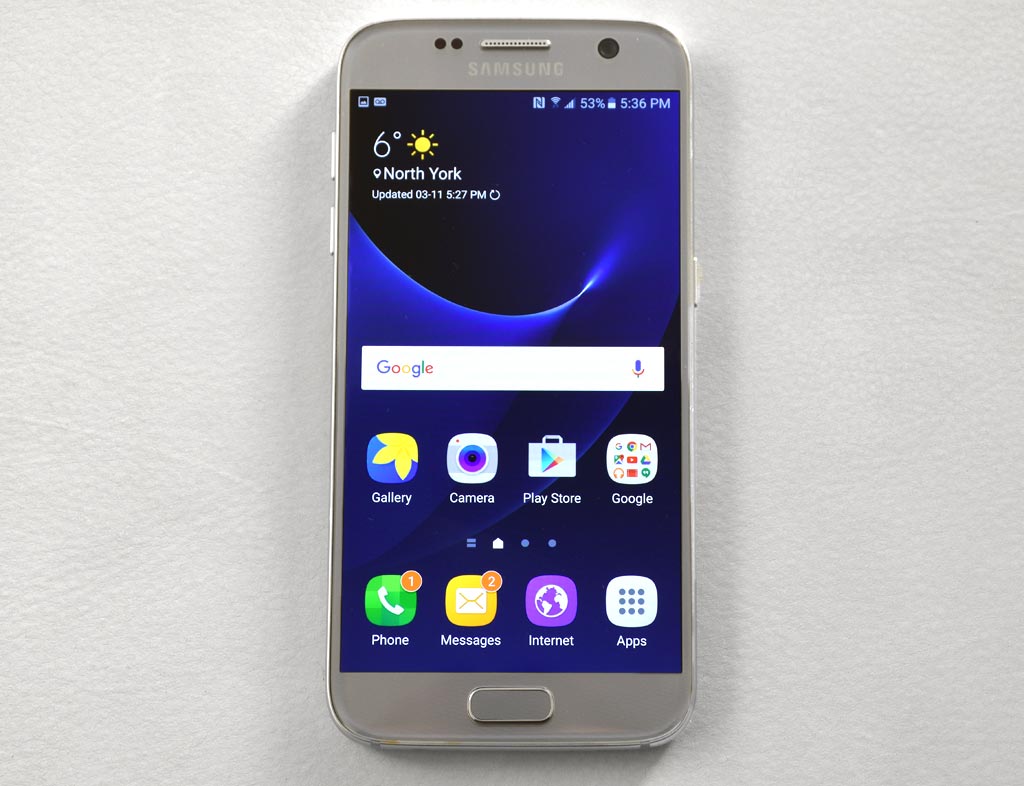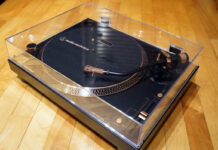
| Samsung Galaxy S7
Display: 5.1-inch 2560 x 1440 Quad HD Super AMOLED with 577 pixels per inch |
Samsung may give a little more precedence to its edged displays, like that on the Galaxy S7 Edge, but the more traditional “flat” Galaxy S7 is another option. Simplifying things to two devices, Samsung has essentially boiled it down to a choice between going with the edge or not. The Galaxy S7 hasn’t been deprived of anything, sporting the same internal specs and overall performance as its edged counterpart, including the incremental additions and improvements.
The Galaxy S7 is the smaller of the duo Samsung launched, with a 5.1-inch Super AMOLED screen. This is the same size going back to the Galaxy S5, and the same resolution as last year’s Galaxy S6, albeit with a negligible drop in pixel density.
Design
Not much changes in the look and feel of this phone. It has the same glass-and-metal design philosophy, including the same placement for most features. Ports, buttons, speaker, microphone and camera are where they were before. The home button still has a fingerprint reader on it, wireless charging is still supported (both Qi and PMA standards) and Fast Charging is also back when you need a quick battery fill.
Of the various incremental moves Samsung made here, one of the biggest is the return of a microSD card slot to expand on the 32GB of internal storage (7GB of which is taken up by system software). The company received some heavy criticism for cutting that in the S6 devices, so this may be one way to ingratiate those users. Water resistance, not seen since the Galaxy S5, is also included here, where the IP68 rating lets it survive up to five feet underwater for up to 30 minutes.
The camera lens is also more flush with the back, eliminating the bump that characterized the S6 models. While there is a slight embossed border around it, it’s barely noticeable when laying the phone down flat. In any case, the glass back is a major fingerprint magnet, regardless of colour. It will look really sleek when wiped with a microfibre cloth, but prints and smudges overtake it very quickly.
Under the hood, the Galaxy S6 runs on the Exynos 8890 octa-core processor. Last year, Samsung opted to outfit all of its flagship models with its own Exynos chips, but has chosen to offer a Snapdragon 820 variant in the U.S. While that might seem odd, or that something might be missing or inferior in this model, the performance is unlikely to be all that different between them.
Beyond that, Samsung didn’t perform much surgery here. As noted, the screen is the same, and the phone doesn’t look all that different from its predecessor until you take a closer look. I will say, however, that it is definitely less hefty. The numbers already indicate that the Galaxy S7 is 24 grams lighter, and it certainly feels that way.
While debatable, the weight loss could also have an effect when using the phone with Samsung’s Gear VR virtual reality headset. The headset isn’t heavy anyway, and I don’t know that I noticed a big difference that way, but it never hurts to go lighter where VR is concerned.
Performance and software
Unlike the S7 Edge, which has its own software layer as part of Samsung’s TouchWiz interface that blends with Android 6.0 Marshmallow, the Galaxy S7 naturally doesn’t have that because there’s no curved display.
And that’s really the only distinction between them. With the same internal components and software, otherwise, there is virtually no distinguishing performance difference between this phone and its larger sibling.
That’s not a bad thing, mind you, because it clarifies the choice between them a great deal. The Galaxy S7 is basically a continuation of what the S6 offered before it, now with the helpful features of Marshmallow included. Samsung has taken to restraining its previous software excesses going back to the S5, which began the process of dialing back some of the gimmicky nonsense.
Ever since, it’s been largely addition by subtraction. Rather than bloating TouchWiz with useless features (it has bloated somewhat in storage, however), the focus has been making the experience fluid and easy for any user. We’re still a far cry from stock Android, like that of the Nexus devices, but it still works. Much of the navigation and menus will already look familiar to any Samsung user, so there is no real learning curve here, especially if you used any of the S6 models.
The fingerprint reader is excellent, performing like its predecessor did. All buttons were highly responsive. My one beef would be with the onboard speaker, which continues to sound tinny and low for a phone of its size and calibre. Playing games, browsing, email, streaming music and the various other tasks you would expect to do with the Galaxy S7 all ran smoothly for me.
The Always-On display, a new feature that shows the time, date, battery level and basic notifications, is one that I suspect will be highly subjective. It’s white text floating over the black screen of the sleeping phone, taking 1% of battery life per hour, according to Samsung. It floats slowly around the screen to avoid “burning in” to the Super AMOLED screen. As I noted with my S7 Edge review, I didn’t mind it being there to show me the time, battery level and basic incoming notifications, except those notifications offered no context. I had no idea when they came in or who they came from. Only waking up the phone to the lock screen could I see those details.
Camera
It might seem like Samsung took a step back by going from a 16-megapixel image sensor to a 12-megapixel one, but the move is actually an improvement. The main reason why is because the sensor has larger micron pixels and a wider f/1.7 aperture lens, both of which take in more light. That translates into better night and low-light photos, especially in Auto mode. Faster autofocusing also comes in handy here.
I’ve gone over the camera’s merits in my review of the S7 Edge, which has the exact same camera, but the gist is that shooting at night or in low-light situations is considerably easier, as a result. Never before with a Samsung handset have I been able to shoot this well at night in Auto mode. Normally, I shoot in the manual Pro mode to control the exposure. I didn’t have to as much with the Galaxy S7.
Daytime shots are also good, as are indoor ones. The fast autofocusing is good in most scenarios, unless you’re trying to shoot a moving object, which is tougher. Double-pressing the home button launches the camera right away, even when the phone is asleep, making it a little easier to shoot quickly.
I found no difference between the Galaxy S7 and the S7 Edge in camera performance, so you can expect the same results, either way. The improved low-light shooting, coupled with some other good shooting modes, makes the Galaxy S7 one of the phones to beat in 2016 for smartphone photography.
Battery life
Despite barely changing the body and adding a microSD card slot, Samsung managed to squeeze in a larger 3000mAh battery, a significant increase from the 2550mAh of the S6. It isn’t removable, but that may not matter because of the improved efficiency. Last year’s models weren’t great that way, and I suspect Android Marshmallow plays a part in the improvements this year.
The Galaxy S7 easily lasted a full day on one charge with moderate usage. Even when I pushed things with video streaming and games, I was pleased with how it held up. I’d hesitate to suggest it’s among the best of any Android flagship, since competitors have yet to launch their devices. It will be interesting to see how they compare at that point.
Fast charging is certainly a big help. It’s not new, of course, but it’s a good way to get a big chunk of battery life in a very short time.
Final Thoughts
As I noted earlier, the Galaxy S7 and S7 Edge are so much alike that the choice really only comes down to whether you want a larger screen or the edged display. This “flat” model has all the benefits, otherwise — solid performance, great camera, good battery life and premium design. You also get the option of an extra colour. The Galaxy S7 comes in black and silver. The S7 Edge is only in black.
The Samsung Galaxy S7 is available now.







